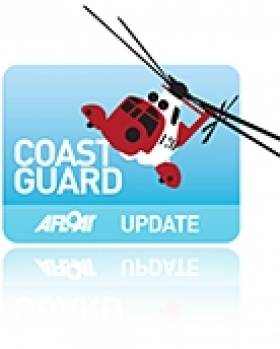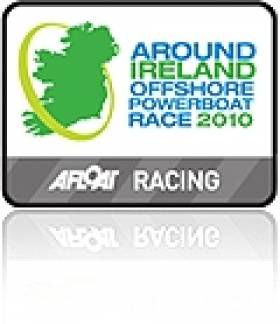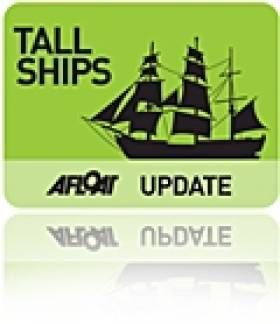Displaying items by tag: Waterford
U.S. Coast Guard Cutter Eagle to visit Waterford
"This is a great opportunity to tie the Eagle's rich history directly into the annual cadet summer training at sea," said Capt. Eric C. Jones, commanding officer. "By the time the ship arrives in Hamburg, the cadets will have shared in an experience that the Coast Guard Academy has shared with prospective officers for 65 years- learning to live and work on the ocean aboard a tall ship."
USCG Eagle is also the only active square-rigger in U.S. government service. Originally the three-masted barque was commissioned for the German Navy. In 1936 the vessel was launched as Horst Wessel from the Blohm & Voss Shipyards, Hamburg. A decade later the 295-foot vessel was taken as war reparation to the U.S Government.
Looking for further reading on Tall Ships in Ireland? Click the links below:
Click this link to read all our Tall Ships Stories on one handy page
Previewing Ireland's Tall Ships 2011 Season
Can Ireland Get a New Tall Ship?
Dunmore East Seal Shooter is Fined, Loses Guns
Waterford Circuit Court has upheld the District Court's prosecution of a fisherman for animal cruelty after the shooting of a seal in Dunmore East harbour.
The unnamed shooter – who was formally licensed by the National Parks and Wildlife Service for animal control – was fined €1,000, barred from further licence for 10 years and given a suspended sentence for 'attitude'. He also had his guns confiscated by the court.
The case followed from an incident in February 2007, when a bull grey seal in Dunmore East harbour was shot at close range and left to die, apparently in full view of tourists and other onlookers.
Grey seals are a protected species under the Wildlife Act 1976, but are often considered a pest within fishing communities.
Brendan Price, director of the Irish Seal Sanctuary, commented after the verdict: "The judge sent out a timely message [to the effect that] such actions against seals and the State will not be tolerated."
Setting Sails for Waterford's Tall Ships Race
The four-day maritime spectacle expects to attract 500,000 visitors to throng the quays of the 'Crystal' city. Presented by Szczecin and organised by Sail Training International, the prestigious event is supported through host-port partners, 3, Bulmers Original Irish Cider and Waterford Crystal. In addition the host-port educational partner is Waterford Institute of Technology and the official media partner covering the event is RTE. Between them over €450,000 has been raised to support funding.
Waterford City Council and the Port of Waterford are providing leading roles as delivering agencies having jointly mounted the bid to secure staging the Tall Ships Races return following the city's successful hosting of the event in 2005.
Notably in that year's 'Parade of Sail' the procession was led by Asgard II, followed astern by Jeanie Johnston and Dunbrody. The involvement of all Irish tall-ships was an historical occasion particularly in view of the sinking of Asgard II three years later.
In 2005, Waterford also claimed to be the first Irish host port to be the starting port for the race and this will be repeated in 2011.
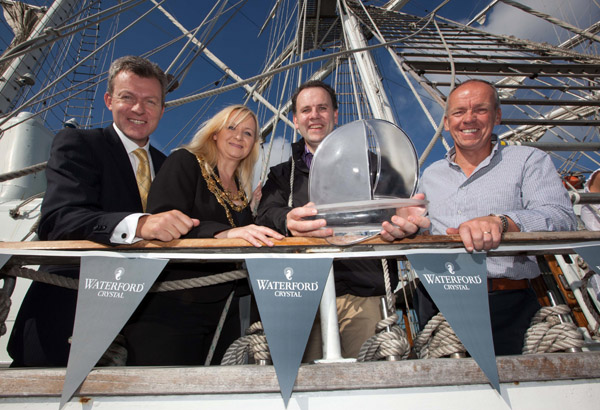
Gary Breen, Failte Ireland; Cllr Mary Roche,Mayor of Waterford,David McCoy, House of Waterford Crystal and Des Whelan, Chairman, The Tall Ships Races 2011 onboard the 'Lord Nelson' in Waterford. Photo: Dylan Vaughan
At the reception onboard Lord Nelson, Cllr Mary Roche, Mayor of Waterford said: "To 3,Bulmers,RTE, Waterford Crystal and Waterford Institute of Technology, I say a very sincere thank you on behalf of the people of Waterford and all of those around Europe and beyond who will be here next summer for what promises to be four magical days of free fun in Ireland's oldest city".
Next year's hosting is also to be supported by Failte Ireland which is allocating resources of €3m while Tourism Ireland will embark on an intensive marketing campaign during the mid summer event, which is billed to be the biggest event in Ireland.
There will be between 80-100 tall-ships and their international crews converging in Waterford. Among the vessels confirmed is the 1937-built, Christian Radich which starred in the 1958 film, The Windjammer and also featured in the 1970's television series, The Onedin Line.
Incidentally the Christian Radich was used, albeit with limited trainee spaces allocated to Coist an Asgard in an arrangement with the vessel's Norwegian owners in 2009, the first full year of the national sail training programme since the sinking of Asgard II the previous year.
The staging costs of the 2011 Tall Ships is estimated at €3.5m and is expected to generate €35m to Waterford City and hinterland. The organisers of the event will be embracing social technology communications networks with presentations on Facebook, Twitter and other servers.
Last year Belfast held the honour in welcoming the finale of the Tall Ship Races, incorporating the Tall Ships Atlantic Challenge. Dublin hosted the event in 1998, albeit the race was then known as the Cutty Sark Tall Ships Race with this same title applying to the race when the event visited Cork Harbour in 1991.
Looking for further reading on Tall Ships in Ireland? Click the links below:
Click this link to read all our Tall Ships Stories on one handy page
Previewing Ireland's Tall Ships 2011 Season
Can Ireland Get a New Tall Ship?
Government Begins Review of Irish Ports
Minister for Transport Noel Dempsey T.D. today announced the launch of a national ports policy review with the publication of a consultation document.
There are ten State commercial port companies established and operating pursuant to the terms of the Harbours Acts 1996 - 2009; Cork, Drogheda, Dublin, Dundalk, Dún Laoghaire, Galway, New Ross, Shannon Foynes, Waterford and Wicklow.
It is estimated that approximately 99% by volume of all goods traded into and out of Ireland are handled at our ports. Dublin Port is the State's biggest port handling approximately 44% of all tonnage in 2009. Cork and Shannon Foynes were the second and third biggest ports respectively in 2009.
Today's consultation document provides stakeholders with an opportunity to help shape future ports policy.
Speaking today Minister Dempsey said; "In 2005 our national Ports Policy Statement outlined national ports policy in a single document for the first time. Since then the commercial, technological, and regulatory environment in which Irish ports operate has changed dramatically, both domestically and globally. It is now time to carry out a review of this policy framework to ensure that our ports are properly positioned for the future.
Since 2005 our ports have experienced both record highs and more recently sharp declines in tonnage throughput. The ports face considerable challenges and it is important that national policy helps address these. The indications are that the country's return to economic growth will be export led. In this regard, it is vital that the ports are in a position to facilitate this and to make their contribution to improving national competitiveness.
I would encourage all interested parties to engage fully in this important consultation process."
The consultation document provides an overview of developments in the sector since 2005 and poses a number of questions on the continued validity and future direction of national ports policy.
Important issues addressed in the document include planning and funding future port developments, the role ports have to play in delivering the "Smarter Travel" agenda, competition within the sector and the corporate governance regime for port companies.
The public consultation period is scheduled to continue until Friday 29th October 2010.
The full Consultation Document is available for download below
To make a submission click HERE
Read Tom MacSweeney's Island Nation blog on the importance of ports HERE
Privatisation of the Ports Should be Strongly Opposed
In the first installment of a new weekly maritime blog on Afloat.ie, marine correspondent Tom MacSweeney says our ports are vital national assets;
It astonishes me that the Government should consider selling off the country’s ten major port companies - Dublin, Cork, Dun Laoghaire, Waterford, Shannon/Foynes, Drogheda, Galway, Wicklow, New Ross and Dundalk.
Ninety-five per cent of Irish exports and imports go by sea through our ports which are the vital entry and exit points of our transport system. To consider privatising them is an example of how unaware the Government is that Ireland is a small island community on the periphery of Europe.
The lesson of transport chaos caused by the Icelandic ash grounding aircraft this year has not been learned. It demonstrated how vital maritime transport is to this island nation.
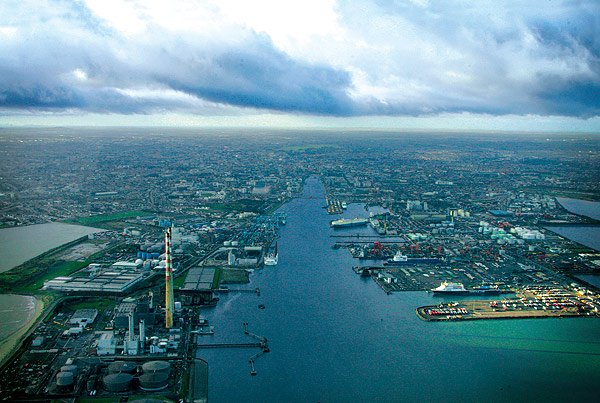
Dublin Port Company - a profitable state company
This is a smash-and-grab raid, redolent of a bankrupt Government philosophy. It is one thing to consider selling off the family jewels when, at least, the householder would still have access to the house. To sell off the ports is akin to the householder selling off the driveway, porch and front door to the house, then having to pay for the right to use them to enter the house in the future.
The Government has failed to develop a national ports policy. In the Progressive Democrat-fuelled era when privatisation, competition and profits were its driving force, the ports were moved out of direct State ownership and turned into semi-State competing bodies. Iarnrod Eireann was permitted to largely opt out of rail freight operations through the ports. Turned loose to compete against each other, the port companies followed no overall national policy for the benefit of the nation and now their future has been put in the hands of a group whose chairman advocates the sale of State companies and has already shown a lack of concern for the marine sector by shutting down the national sail training programme.
Aspects of journalism these days disappoint me after 45 years in the profession. Colm McCarthy who led Bord Snip Nua, is now chairing what is, effectively, ‘board privatisation,’ yet sections of the media seem largely to accept his views without question. I have not seen a lot of reportage which refers to his scathing opposition to the building of the DART, the Dublin Area Rapid Transport system, which he described as financial insanity and profligacy. Had those views been accepted, there would be no DART in Dublin, the consequences of which today are interesting to consider.
Privatisation of the ports should be strongly opposed. These are vital national assets. The lesson of selling-off Eircom has also, apparently, been forgotten by the Government.
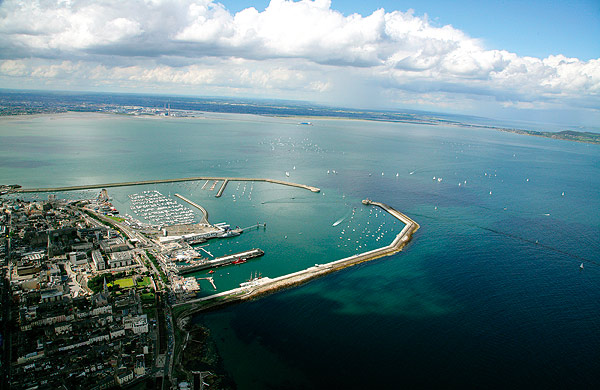
Dun Laoghaire Port on Dublin Bay
A Republic should be an entity in which there is open debate about public policy, not decision-making by elites. Flogging off our best assets, which is what this move by the Government is about, will not solve the nation’s problems. It is shocking to think that money from the sale of our vital transport arteries, the ports, could go to benefit those property speculators and banks which have bankrupted this nation.
This article is reprinted by permission of the CORK EVENING ECHO in which Tom MacSweeney writes maritime columns twice weekly. Evening Echo website: www.eecho.ie
Coastguard Pilot Flies 500th Mission
Minister for Transport Noel Dempsey yesterday congratulated an Irish Coast Guard pilot who has just completed his 500th rescue mission, becoming one of a handful of helicopter pilots in western Europe to have done so.
On July 11, operating from the Irish Coast Guard base at Waterford, Capt Rayner and his crew attended an incident 10 nautical miles east of Waterford Airport, where multiple casualties were in difficulty in the water.
On rescuing the party, one injured male was transferred to Waterford Regional Hospital for treatment. With that operation, Capt Rayner joined an elite group of SAR crewmembers who have achieved an impressive 500 rescue missions during their careers.
Ireland’s Minister for Transport, Noel Dempsey, said: "Martyn epitomises the dedication, experience and expertise that makes the Irish Coast Guard one of the best in the world. I congratulate him on his achievement of 500 rescue missions and wish to publicly commend the valuable contribution he has made, and continues to make to SAR in Ireland."
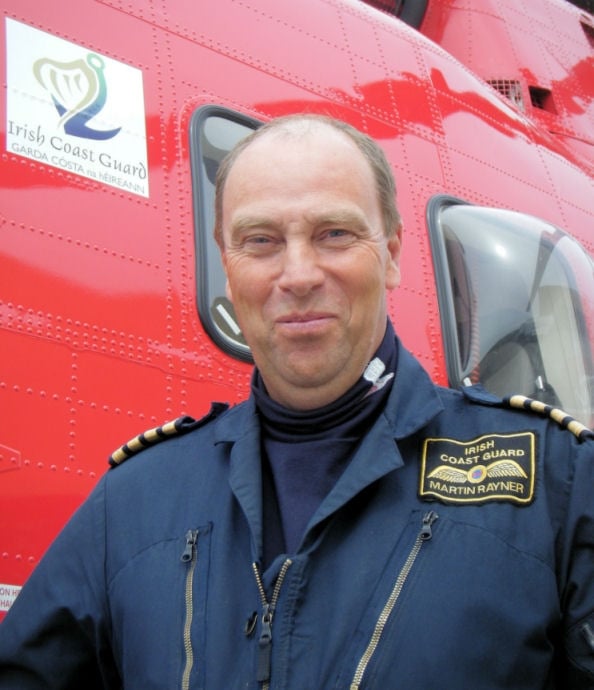
He commenced flying on the Irish Coast Guard contract in 1991 to set up the first Irish Coast Guard SAR base in Shannon Airport. Over the following 10 years Capt Rayner guided the Shannon base as chief pilot, line trainer and SAR Captain. He spent many years flying West of Shannon in all weather conditions, commanding the R115 Shannon base on missions far into the Atlantic Ocean.
“We are delighted for Martyn. This level of experience is rarely seen amongst SAR crew worldwide. We are very pleased to have the benefit of Martyn’s calibre of experience flying SAR missions around our coast,“ said Mark Kelly, managing director of CHC Ireland.
“Most SAR pilots fly an average of 20 missions per year. Martyn has been accident free for his entire career with CHC and is a shining example of our commitment to safety.”
In 2002 Capt Rayner, along with his wife Maureen, temporarily left Irish SAR for the Far East to fly offshore of Brunei. He returned to Ireland in 2005 and was welcomed with open arms to the newly established Waterford Base.
“Everyone at CHC is immensely proud of Capt Rayner’s unique achievement in reaching 500 missions. His vast experience, patience, sense of humour and knowledge of SAR is the backbone of our operation today,“ said Capt Dara Fitzpatrick, chief pilot, CHC Waterford Base.
CHC Ireland is an affiliate of CHC Helicopter through its ownership interest in EEA Helicopter Operations B.V. CHC Helicopter is the world’s largest offshore helicopter operator and provides civilian search and rescue services in Ireland, the UK, Denmark and Australia. Earlier this month another CHC SAR crew was recognized with a “Best of Irish” award for their role in successfully recovering the pilot of a light aircraft that crashed in the Irish Sea.
Local Galway Flyer was forced to retire from the second leg of the race due to an electrical failure yesterday but after a tow in to Bangor the high speed powerboat started the third leg from Bangor to Waterford this morning but this afternoon the race tracker shows Enda O'Coineen's entry has pulled into Dun Laoghaire as the fleet leader arrived in Waterford.
First into Waterford is Cinzano Bianco after a 220-mile completed in approximately 5 to 6 hours. Race results so far below:
Leg 1 Race results: Galway to Killybegs - 174 miles1st Cinzano Bianco: Time taken: 4 hours, 11 minutes, 38 seconds. Average speed 39.35Knots
2nd Sea Wolf: Time taken: 5 hours, 4 minutes, 26 seconds. Average speed 32.35Knots 3rd Wolf: Time taken: 5 hours, 27 minutes, 42 seconds. Average speed 30.21KnotsLeg 2 Race results: Killybegs to Bangor - 176 miles
Leg 2 Killybegs to Bangor: 1st Cinzano Bianco at 13h10. Elapsed time: 3 hours, 48 minutes, 05 seconds. Average speed 43.41Knots2nd Sea Wolf at 13h53. Elapsed time: 4 hours, 31 minutes, 30 seconds. Average speed 36.46 Knots3rd Wolf at 13h58. Elapsed time: 4 hours, 35 minutes, 59 seconds. Average speed 35.87 Knots4th Zoolander at 15h14. Elapsed time: 5 hours, 52 minutes, 40 seconds. Average speed 28.07 Knots
Waterford subsidising 20 tall ships sailors
In advance of the return of The Tall Ships Races to Waterford in 2011, 20 young people are being offered a unique opportunity to experience life on the ocean and take part in the 2010 Race as a Trainee crew member.
Waterford City Council is offering 20 young people sponsorship of €500 to participate in one of the most exciting legs of this year's race, sailing from Kristiansand in Norway to Hartlepool in the UK. Those interested should contact [email protected] or phone 051 849640 by 15th May 2010. Mayor of Waterford, Cllr. John Halligan said, “We recognise the sail training programme as one of the most important aspects of The Tall Ships Races. Becoming a trainee crew member offers young people an incredible experience and through this sponsorship, Waterford City Council is making it easier than ever before for young people to participate. Supporting the sail training experience is something we are very happy to do and marks our commitment to the event, which will return to Waterford in 2011.”
Young people from over 30 countries will take part in this unique event that combines four days of activities in each port. Becoming a crew member on one of the ships is not only a fantastic adventure, but is also seen as hugely positive in the personal development of those taking part. Being part of the crew involves discipline and hard work, but lifelong friendships are built and the fun had by those on-board makes for an unforgettable and life-changing experience.
The voyage for the 20 successful applicants begins on Friday 30th July, or Saturday 31st July (depending on the vessel chosen by the Trainee) and finishes either on Sunday, 8th August or Monday, 9th August 2010. Applicants for the programme must be at least 18 and no older than 25 years old by 30th June, 2010. No prior sailing experience is required, just a thirst for adventure and willingness to participate in a dedicated and hardworking sail team.
Full fees for the programme are expected to be in the region of €1,000 (of which, €500 will be subsidised) and includes the flight to Norway and return flight from the UK. Those unable to join The Tall Ships Races this year can still apply for one of 100 places available next year, by contacting [email protected].
The Tall Ships Races will bring over 70 Tall Ships and their crews to Waterford in 2011, with over 500,000 people expected to attend the Tall Ships Festival for what will be Ireland’s biggest festival next year. The Tall Ships Races are presented by Szczecin and organised by Sail Training International. Further information is available at www.waterfordtallshipsrace.ie and www.sailtraininginternational.org.
Dungarvan Harbour Sailing Club

Dungarvan Harbour Sailing Club
Dungarvan has always been noted for its sailors and its great sea-faring families and the tradition of the bygone days of the coastal schooners is reflected there today in the strong active sailing club which was founded at a public meeting in the Town Hall on Friday 2nd August 1946. The first officers were Bernard Mulcahy, Commodore, Reveille Farrell, Vice Commodore, Maurice Kiely, Secretary and Joe Donovan, Treasurer.
Left: The Clubhouse
The inaugural race of the club, for the newly presented Mulcahy Cup, was held over a 6½ mile course with a fleet of four boats; Mairead built by Tyrells and owned by Bernard Mulcahy, Maise formerly of Dublin owned by Maurice and Peter Kiely, Naomh Breandáin owned by Gerard Walsh, and Jane Shore owned by James Villiers Stuart. The race was won by Maurice and Peter Kiely.
Helvick based boats then showed an interest and these craft, mostly gaff rigged salmon boats crewed by fishermen from the Helvick and Ring Gaeltacht, were usually well placed. Amongst these 'Pauls Boat' and 'Slatterys Boat' were outstanding, leaving the 'yachts' a poor second on more than one occasion.
In 1948 Reveille Farrell bought Susanna, a nine-ton Bermudan cutter designed by Norman Dallimore and built in 1936. She was to become well known for her many cruises to the West Coast of Ireland, in the English Channel, and Brittany. The most famous of these was in June 1957 when accompanied by Gerard Walsh and John Ballot she sailed to Spain and back. This was a considerable achievement at the time as it was believed that the passage across the Bay of Biscay and back again was beyond the capacity of the average cruising yacht in the normal holiday period. Coincidental with the arrival of “Susanna” some of the older boats changed hands and were lost to the club and big boat racing activity declined. They were replaced by a number of one man canvas sailing canoes, owned and frequently capsized by Col. Jack Hockin, Maurice Kiely, and Tim MacCarthy – which were the beginnings of dinghy sailing in Dungarvan Harbour.
During the winter of 1958, John and Austin Flynn built a 16’ hard chine Petrel class dinghy from plans in an American magazine. Because the design was ideally suited for home construction many Petrels quickly followed and dinghy sailing really became established in Dungarvan. There was great rivalry and competition in the fleet and each new boat came with a further refinement or new 'secret weapon' not seen on previous models. Construction methods changed from larch planking and cotton sails to plywood and terylene. In all 50 boats of the class are known to have been built, the later ones of GRP construction. An unfortunate drawback of the Petrel was the fact it was unique to Dungarvan and those interested in inter club competition had to look to other designs to compete nationally.
GP14s were popular for a while during which period the club hosted the Purcell trophy. Nowadays the dinghy fleet comprises of Wayfarers, Lasers, Mirrors and Toppers sailed by a very active junior section.
The cruiser fleet has also expanded and the burgee of DHSC has been carried far afield and its members have logged many miles from Cape Horn to the Northern Latitudes.
Although once a busy commercial port, Dungarvan in common with many other ports of its size suffered when changes in shipping practices led to a decline in the number of vessels using the port and with trade totally finished many of the old warehouses along the quayside became derelict. Reconstruction has injected new life into this area of the town and created the opportunity for Dungarvan Harbour Sailing Club to acquire a site on the quay front on which to build a clubhouse which is now the focal point of club activities.
The Town Council is currently progressing the construction of a marina, which together with the abundance of new restaurants and other onshore facilities available will firmly establish Dungarvan as a compulsory stopover for cruising yachts and greatly ease the current shortage of mooring space in the harbour.
DHSC is a family orientated club. Visitors by road and sea are welcome. Pontoons at quayside. Showers and toilets available in the Clubhouse to visitors. The Clubhouse and bar are open at the weekend from 5pm throughout the year, dinghy and cruiser racing and cruising in company during the summer.
(The above information and image courtesy of Dungarvan Harbour Sailing Club)
Dungarvan Harbour Sailing Club, c/o Andrew Corby, Davitt's Quay, Dungarvan, Co Waterford. Tel: 058 45663, email: [email protected]
Have we got your club details? Click here to get involved































